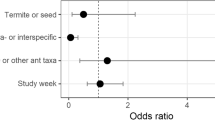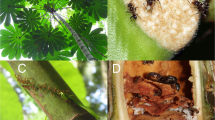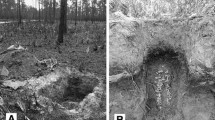Summary
This field study examines the social behavior of five sympatric species of desert seed-eating ants (Pogonomyrmex barbatus, P. rugosus, P. maricopa, P. desertorum, P. californicus). The species differed significantly in measures of activity rhythms in various colony tasks, use of space around the nest yard, and reaction to disturbance. Species differences were related to the typical size of a colony's outside work force. The behavior ofP. rugosus, P. barbatus, andP. maricopa, which had larger outside work forces, emphasized territoriality and the acquisition of food; that ofP. desertorum andP. californicus, which had smaller outside work forces, emphasized the avoidance of contact with other colonies. Examining the patterns in colony behavior can illuminate interspecific relationships in desert ant communities.
Resume
Cette étude faite sur le terrain dans le désert du sud-ouest des Etats-Unis différencie le comportement social de cinq espèces de fourmis moissonneuses:Pogonomyrmex barbatus, P. rugosus, P. maricopa, P. desertorum, P. californicus. Les espèces diffèrent significativement quant à leurs rythmes d'activité pour plusieurs tâches (fourragement, maintien du nid, surveillance, maintien des débris, rassemblement), ainsi que pour l'utilisation de l'espace autour du nid et la réaction de la societé à un dérangement. En général, les différences de comportement peuvent s'organiser en fonction de la quantité habituelle d'ouvrières hors du nid. Chez les espèces ayant une plus grande quantité d'ouvrières à l'extérieur du nid, l'organisation de la société met plus en valeur l'acquisition de la nourriture et la territorialité. Par contre, les espèces ayant moins d'ouvrières hors du nid ont un comportement social qui leur permet de réduire leur contact avec d'autres sociétés. En examinant les régularités temporelles et spatiales du comportment social, on peut mieux comprendre les rapports interspécifiques chez les communautés de fourmis.
Similar content being viewed by others
References
Bernstein R.A. 1975. — Foraging strategies in response to variable food density.Ecology, 56, 213–219.
Carroll C.R., Janzen D.H., 1973. — Ecology of foraging by ants.Ann. Rev. Ecol. Syst., 4, 231–259.
Chew R.M., 1976. — Foraging behavior of Chihuahuan desert foraging ants.Am. Midl. Nat., 95, 455–458.
Culver D.C., 1974. — Species packing in Carribean and north temperate ant communities.Ecology, 55, 947–988.
Davidson D.W., 1977 a. — Species diversity and community organization in desert seedeating ants.Ecology, 58, 711–724.
Davidson D.W., 1977b. — Foraging ecology and community organization in desert seedeating ants.Ecology, 58, 725–737.
Davidson D.W., 1980. — Some consequences of diffuse competition in a desert ant community.Am. Nat., 116, 92–105.
De Vita J., 1979. — Mechanisms of interference and foraging among colonies of the harvester antPogonomyrmex californicus in the Mojave desert.Ecology, 60, 729–734.
Gordon D.M., 1983. — The relation of recruitment rate and activity rhythms in the harvester antPogonomyrmex barbatus J. Kans. Entomol. Soc., 56, 277–285.
Hansen S.R., 1978. — Resource utilization and coexistence of three species ofPogonomyrmex ants in an upper Sonoran grassland community.Œcologia, 35, 109–117.
Harrison J.S., Gentry J.B., 1981. — Foraging patterns, colony distribution and foraging range of the Florida harvester antPogonomyrmex badius.Ecology, 62, 1467–1473.
Hölldobler B., 1976a. — Recruitment behavior, home range orientation, and territoriality in harvester ants,Pogonomyrmex.Behav. Ecol. Sociobiol., 1, 3–44.
Hölldobler B., 1976b. — The behavioral ecology of mating in harvester ants (Pogonomyrmex).Behav. Ecol. Sociobiol., 1, 405–423.
Rissing S.W., 1981. — Prey preferences in the desert horned lizard: influence of prey foraging method and aggressive behavior.Ecology, 62, 1031–1040.
Sokal R.R.,Rohlf F.J., 1981. —Biometry, 2nd Ed., San Francisco, W.H. Freeman.
Spiegel S., 1956. —Nonparametric statistics for the behavioral sciences, New York, Mc-Graw-Hill.
Timm N.H., 1975. —Multivariate analysis, Monterey, CA, Brooks/Cole Publishing Co.
Whitford W.G., 1978. — Foraging in seed-harvester antsPogonomyrmex spp.Ecology, 59, 185–189.
Whitford W.G., Ettershank G., 1975. — Factors affecting foraging activity in Chihuahuan desert harvester ants.Env. Entomol., 4, 689–696.
Whitford W.G., Johnson P., Ramirez J., 1976. — Comparative ecology of the harvester antsPogonomyrmex barbatus (F. Smith) andPogonomyrmex rugosus (Emery)Ins. Soc., 23, 112–132.
Wilson E.O., 1971. —The insect societies, Cambridge, MA, Belknap Press.
Author information
Authors and Affiliations
Rights and permissions
About this article
Cite this article
Gordon, D.M. Species-specific patterns in the social activities of harvester ant colonies (Pogonomyrmex). Ins. Soc 31, 74–86 (1984). https://doi.org/10.1007/BF02223693
Received:
Accepted:
Issue Date:
DOI: https://doi.org/10.1007/BF02223693




